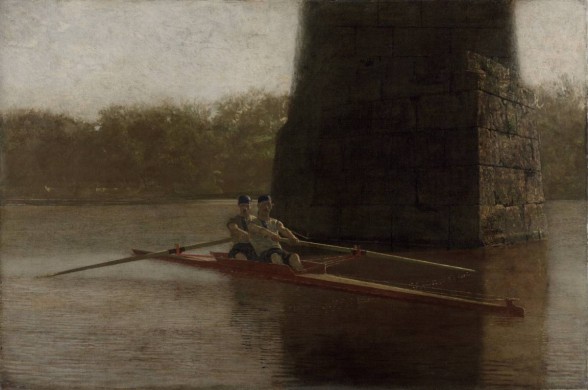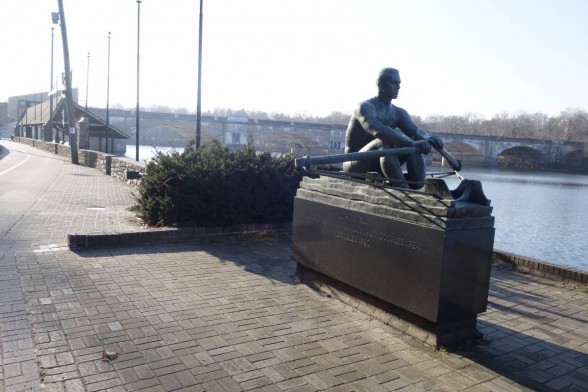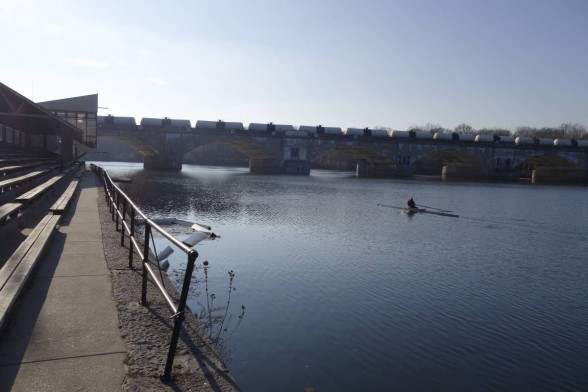[Marvin takes a close eye to a classic Realist painting, applying his knowledge of rowing to dissect the deeper meaning of Thomas Eakins’ work. — the Artblog editors]
The picturesque scene of Boathouse Row on the banks of the Schuylkill River has become synonymous today with American rowing culture. But for Philadelphia Realist artist Thomas Eakins (1844-1916), who was an amateur rower himself, his now-famous rowing paintings were his attempt to raise to iconic status the spirit of the sport: a human athleticism and grace pitted against the might and beauty of the river.
For those who have experienced that moment when you and your fellow oarsmen launch off a dock and place your hands on an oar, there is a quiet, instinctive link between everyone. This sense of camaraderie may be another layer, beyond the paint, that Eakins hoped to suggest.
Things change, yet stay the same

As a former oarsman myself, and now coach to young athletes, I was immediately drawn to the enigmatic quality of Eakins’ rowing paintings–the simple subject of a man or men at rest in a boat. Yet, what can we learn from these paintings? To better understand the “art of rowing,” I reached out to Colin Farrell, head coach of the University of Pennsylvania Men’s Lightweight Crew team, and together we visited “The Pair-Oared Shell” (1872) at the Philadelphia Museum of Art to closely analyze it.
Looking at the painting through the lens of a rower and coach dramatically changes what we see on the canvas. At our first immediate glance, Farrell and I deduce that the sport has not changed since Eakins’ days. Other than modifications in apparel and some improved equipment–rowers are discouraged from wearing any loose, baggy clothing, for it may interfere with the stroke or get caught on the rolling seat beneath them; carbon-shaft oars replaced wooden oars; and the rowing “shell,” or boat, is now made out of carbon fiber rather than wood–the stroke essentially remains the same.

This was the first of several paintings depicting the famed professional oarsmen brothers John and Bernard (Barney) Biglin from New York, rowing on the Schuylkill River. Here, Farrell and I deconstruct the scene: John sits in “stroke” seat, closest to the stern (back) of the shell, and Barney, the “bowman,” makes the steering calls as he follows his brother, who sets the boat’s rhythm and speed. The men row a pair-oared shell (that is, a two-person boat where one sits in front of the other and each person has one oar); John rows starboard (his left side) and Barney rows port (his right side) through the old Columbia Railroad Bridge. We believe it is a calm practice out on the Schuylkill just before sunset. The brothers’ relaxed bodies and their synchronized motion control the balance of the boat.
Tranquil waters, subtle choices
Farrell and I note that Eakins catches the brothers midway through the complex and rhythmic rowing cycle called the stroke. Let us explain: After using their legs to push against a foot stretcher inside the boat, the brothers are about to approach the bow (the front part of the shell; the back part if you are rowing). This stage, when the blade (the face of the oar) is pulled through the water, is commonly known as the “drive”. Utilizing the major muscle groups (a firm connection between the legs and back) and keeping their arms long and extended, the brothers will eventually end their stroke at the “finish” with the handle against their chest before proceeding onto the next stroke.
At the finish, the rower sits tall, with his knees down. To release the blade from the water, he must push his handle down and away (arms and body pivoted forward) and “feather” the blade by rotating the oar with the inside hand, making the blade parallel to the water’s surface before commencing the “recovery,” when the legs compress as the body slides forward. He then “squares” the blade by rolling his inside hand’s fingers on the handle and placing the blade into the water at the “catch”. With the drive of the legs, the rower opens up his body, brings the handle back to his chest and leans back at the finish before the new stroke. Keep in mind this is all one continuous motion without hesitation.

Interestingly, we note that the water has been altered for artistic purposes: Although the brothers may be rowing a practice at low cadence and low intensity, Eakins did not paint any water disturbance. In reality, after every stroke a trail of puddles forms as a boat runs through the water.
It’s also interesting to Farrell and me that Barney’s body seems to be exaggerated. His torso is slightly twisted toward the viewer and his right knee is positioned uncomfortably. In rowing, the person’s body must be centered throughout the movement. Any bodily adjustments can easily unset the boat’s balance.
There is certainly an otherworldly presence evoked by the two men, who seemingly pose for Eakins as if he were taking a photograph of them (Eakins was fond of Eadweard Muybridge’s locomotion photographs, and he, in fact, took photographs himself). Likewise, the way Eakins portrayed the shell on the water makes it appear to float in thin air.
For an artist who devoted countless hours to large preliminary drawings and pinpointing where his subjects would be placed on a marked canvas, why would Eakins knowingly create an imaginary perspective? A closer observation of Eakins’ mastery of the brush allows viewers to fully apprehend his vision. We deduce he made these adjustments for strategic, perhaps symbolic reasons. The sunset cast on the rowers’ left side heightens their roles as premier athletes. Eakins’ use of subtle light highlights the Biglins’ toned muscles–a result of the men’s industrious commitment to the sport–as well as the laborious craftsmanship of the shell itself. The composition’s neutral palette is as relaxing as the Biglins’ strokes.

Any coach might reprimand the rowers for doing so, but the brother athletes stare at the viewer when their heads should be facing straight forward, so as not to upset the balance. Eakins quite possibly intended the Biglins to stare out of the boat to eternalize their pride and finesse beyond this afternoon practice. The artist’s choice is an iconic pose of humans working well, cleanly, and together to move the boat. This is an enduring reminder of the sport itself, and it could well indicate Eakins’ metaphorical statement about life in general.
“The Pair-Oared Shell” is on display at the Philadelphia Museum of Art in the American Art galleries.









